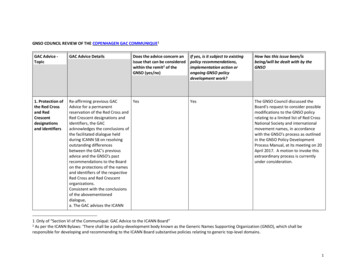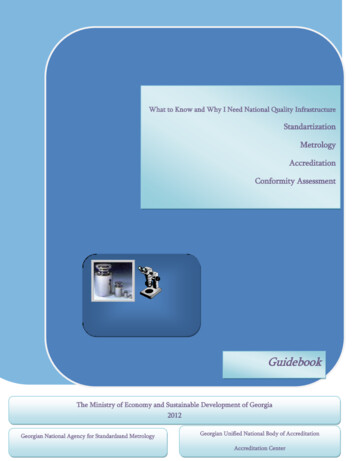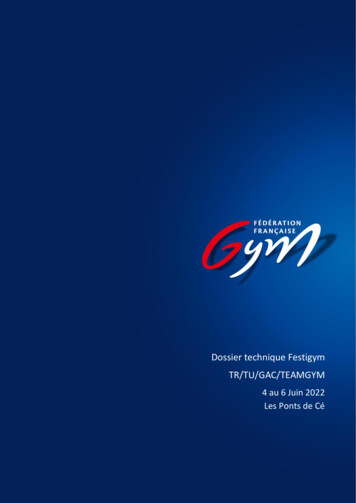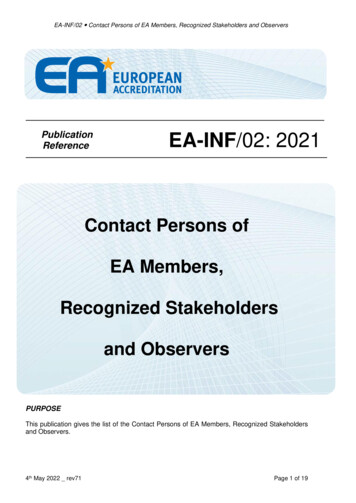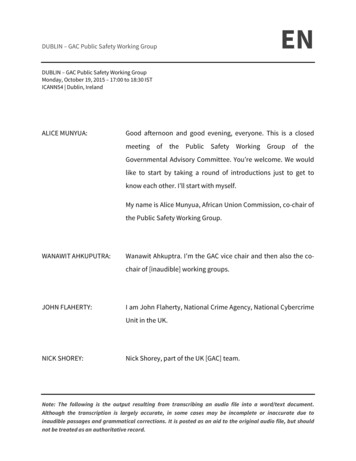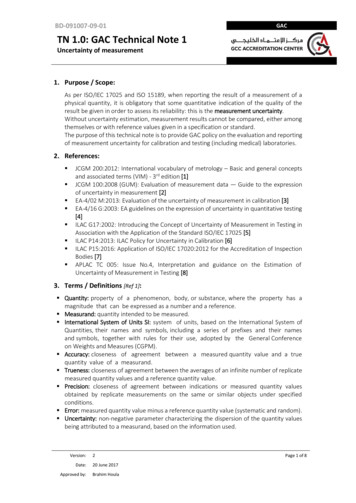
Transcription
BD-091007-09-01GACTN 1.0: GAC Technical Note 1Uncertainty of measurement1. Purpose / Scope:As per ISO/IEC 17025 and ISO 15189, when reporting the result of a measurement of aphysical quantity, it is obligatory that some quantitative indication of the quality of theresult be given in order to assess its reliability: this is the measurement uncertainty.Without uncertainty estimation, measurement results cannot be compared, either amongthemselves or with reference values given in a specification or standard.The purpose of this technical note is to provide GAC policy on the evaluation and reportingof measurement uncertainty for calibration and testing (including medical) laboratories.2. References: JCGM 200:2012: International vocabulary of metrology – Basic and general conceptsand associated terms (VIM) - 3rd edition [1]JCGM 100:2008 (GUM): Evaluation of measurement data — Guide to the expressionof uncertainty in measurement [2]EA-4/02 M:2013: Evaluation of the uncertainty of measurement in calibration [3]EA-4/16 G:2003: EA guidelines on the expression of uncertainty in quantitative testing[4]ILAC G17:2002: Introducing the Concept of Uncertainty of Measurement in Testing inAssociation with the Application of the Standard ISO/IEC 17025 [5]ILAC P14:2013: ILAC Policy for Uncertainty in Calibration [6]ILAC P15:2016: Application of ISO/IEC 17020:2012 for the Accreditation of InspectionBodies [7]APLAC TC 005: Issue No.4, Interpretation and guidance on the Estimation ofUncertainty of Measurement in Testing [8]3. Terms / Definitions [Ref 1]: Quantity: property of a phenomenon, body, or substance, where the property has amagnitude that can be expressed as a number and a reference. Measurand: quantity intended to be measured. International System of Units SI: system of units, based on the International System ofQuantities, their names and symbols, including a series of prefixes and their namesand symbols, together with rules for their use, adopted by the General Conferenceon Weights and Measures (CGPM). Accuracy: closeness of agreement between a measured quantity value and a truequantity value of a measurand. Trueness: closeness of agreement between the averages of an infinite number of replicatemeasured quantity values and a reference quantity value. Precision: closeness of agreement between indications or measured quantity valuesobtained by replicate measurements on the same or similar objects under specifiedconditions. Error: measured quantity value minus a reference quantity value (systematic and random). Uncertainty: non-negative parameter characterizing the dispersion of the quantity valuesbeing attributed to a measurand, based on the information used.Version:2Date:20 June 2017Approved by:Brahim HoulaPage 1 of 8
BD-091007-09-01GACTN 1.0: GAC Technical Note 1Uncertainty of measurement Combined standard uncertainty (uc): standard measurement uncertainty that is obtainedusing the individual standard measurement uncertainties associated with the inputquantities in a measurement model. Expanded uncertainty (U): product of a combined standard measurement uncertainty anda factor larger than the number one. Coverage factor (k): number larger than one by which a combined standard measurementuncertainty is multiplied to obtain an expanded measurement uncertainty. Calibration: operation that, under specified conditions, in a first step, establishes a relationbetween the quantity values with measurement uncertainties provided by measurementstandards and corresponding indications with associated measurement uncertainties and,in a second step, uses this information to establish a relation for obtaining a measurementresult from an indication. Verification: provision of objective evidence that a given item fulfils specified requirements. Metrological traceability: property of a measurement result whereby the result can berelated to a reference through a documented unbroken chain of calibrations, eachcontributing to the measurement uncertainty.4. GAC Policy [Ref 5]: The GUM, ISO 5725 and ISO/IEC 17025 form the basic documents but sector specificinterpretations may be needed; The basis for the estimation of uncertainty of measurement is to use existing experimentaldata (quality control charts, validation, round robin tests, PT, CRM, handbooks etc.); Calibration and testing laboratories shall document fully their procedures for theestimation of measurement uncertainty and shall be able to show records of it beingimplemented for a period of at least 3 months prior to the assessment; Calibration laboratories shall report their CMC on the accreditation schedule as detailed inILAC document P14. This requirement is applicable for testing/medical laboratoriesperforming in-house calibrations but without publishing the capabilities in theiraccreditation schedule, Calibration laboratories shall report their measurement of uncertainty on all calibrationcertificates as per ISO/IEC 17025. This requirement is applicable for testing/medicallaboratories performing in-house calibrations; When using a standard test method there are three cases: when using a standardized test method, which contains guidance to the uncertaintyevaluation, testing laboratories are not expected to do more than to follow theuncertainty evaluation procedure as given in the standard; if a standard gives a typical uncertainty of measurement for test results, laboratoriesare allowed to quote this figure if they can demonstrate full compliance with the testmethod; if a standard implicitly includes the uncertainty of measurement in the test resultsthere is no further action necessary. The required depth of the uncertainty estimations may be different in different technicalfields. Factors to be taken into account include: Common sense; Influence of the uncertainty of measurement on the result;Version:2Date:20 June 2017Approved by:Brahim HoulaPage 2 of 8
BD-091007-09-01GACTN 1.0: GAC Technical Note 1Uncertainty of measurement Appropriateness; Classification of the degree of rigor in the determination of uncertainty ofmeasurement. In certain cases, it can be sufficient to report only the reproducibility; When information about estimation of the uncertainty of measurement is limited, anyreport of the uncertainty should make this clear.The acceptable approaches for estimating measurement uncertainties for calibration andtesting are detailed in the following paragraphs.5. Calibration Laboratories:5.1. GUM approach:The basic concepts in uncertainty evaluation are:- the knowledge about any quantity that influences the measurand is in principleincomplete and can be expressed by a probability density function (PDF) for the valuesattributable to the quantity based on that knowledge ,- the expectation value of that PDF is taken as the best estimate of the value of thequantity,- the standard deviation of that PDF is taken as the standard uncertainty associated withthat estimate,- the PDF is based on knowledge about a quantity that may be obtained from repeatedmeasurements—Type A evaluation,- Scientific judgement based on all the available information on the possible variabilityof the quantity—Type B evaluation.Hereinafter, the typical steps for calculating the uncertainty of measurement based onGUM approach:a. Express in mathematical terms the dependence of the measurand (output quantity) Yon the input quantities Xi according to equation Y f(X1,., XN). In the case of a directcomparison of two standards the equation may be very simple, e.g. Y X1 X2 ,b. Identify and apply all significant corrections,c. Enumerate all sources of uncertainty in the form of an uncertainty analysis,d. Calculate the standard uncertainty for repeatedly measured quantities: Type-Aevaluation,e. For single values, e.g. resultant values of previous measurements, correction values orvalues from the literature, adopt the standard uncertainty where it is given or can becalculated according to paragraph 4.3 of GUM [Ref 2]. If no data are available fromwhich the standard uncertainty can be derived, state a value of u(xi) on the basis ofscientific experience: Type-B evaluation,f. Calculate the combined uncertainty uc(y) according to the following equation:2n 1 n f 2 f fu ( y) .u(x) 2.u ( xi , x j ) i i 1 xi i 1 j i 1 xi x jn2CVersion:2Date:20 June 2017Approved by:Brahim HoulaPage 3 of 8
BD-091007-09-01GACTN 1.0: GAC Technical Note 1Uncertainty of measurementIf input quantities are known to be non-correlated, apply the following simple form:2 f 2u ( y) .u ( xi )i 1 xi n2Cg. Calculate the expanded uncertainty U by multiplying the standard uncertainty uc(y)associated with the output estimate by a coverage factor k chosen in accordance withparagraph 6 of GUM [Ref 2]y - U Y y U orY y Uh. Report the result of the measurement comprising the estimate y of the measurand,the associated expanded uncertainty U and the coverage factor k in the calibrationcertificate in accordance with Section 6 of ILAC P14 [Ref 6] and of ILAC P15 [Ref 7].i. Determine compliance with a specification: decision on when and how to reportcompliance or non-compliance with a specification vary according to the requirementsof the client and other interested parties. However, the laboratory should considermeasurement uncertainty appropriately, when making compliance decisions, andclients should not be misled in relation to the reliability of such decisions.5.2. Applicable requirements of ILAC P14: A CMC is a calibration and measurement capability available to customers under normalconditions:a. as described in the laboratory’s scope of accreditation granted by a signatory tothe ILAC Arrangement; orVersion:2Date:20 June 2017Approved by:Brahim HoulaPage 4 of 8
BD-091007-09-01GACTN 1.0: GAC Technical Note 1Uncertainty of measurementb. as published in the BIPM key comparison database (KCDB) of the CIPM MRA. The scope of accreditation of an accredited calibration laboratory shall include thecalibration and measurement capability (CMC) expressed in terms of:a. Measurand or reference material;b. Calibration/measurement method/procedure and/or type of instrument/materialto be calibrated/measured;c. Measurement range and additional parameters where applicable, e.g., frequencyof applied voltage;d. Uncertainty of measurement. The uncertainty covered by the CMC shall be expressed as the expanded uncertainty havinga specific coverage probability of approximately 95 %. The unit of the uncertainty shallalways be the same as that of the measurand or in a term relative to the measurand, e.g.,percent. An accredited laboratory is not permitted to report an uncertainty smaller than itsaccredited CMC. The magnitude of the uncertainty reported on a certificate of calibrationdepends on properties of the device being calibrated.No device is perfect and so the concept of a “best existing device” is used in associationwith the evaluation of a CMC. CMC uncertainty statements therefore incorporate agreedvalues for the best existing devices. Where necessary, the laboratory's schedule ofaccreditation includes remarks that describe the conditions under which the CMC can beachieved.5.3. Other information:The BIPM JCGM (Joint Committee for Guides in Metrology) is publishing a series ofdocuments to accompany the GUM, such as:- JCGM 101:2008: Evaluation of measurement data – Supplement 1 to the "Guide to theexpression of uncertainty in measurement" – Propagation of distributions using aMonte Carlo method,- JCGM 102:2011: Evaluation of measurement data – Supplement 2 to the "Guide to theexpression of uncertainty in measurement" – Extension to any number of outputquantities,- JCGM 106:2012: Evaluation of measurement data – The role of measurementuncertainty in conformity assessment.6. Testing Laboratories [Ref 4]:A quantitative test result is considered to be a measurement result in the sense used in theGUM. The important distinction is that a comprehensive mathematical model, whichdescribes all the effects on the measurand, is less likely to be available in testing. Theevaluation of uncertainty in testing may therefore require the use of validation and methodperformance studies as described hereinafter.Version:2Date:20 June 2017Approved by:Brahim HoulaPage 5 of 8
BD-091007-09-01GACTN 1.0: GAC Technical Note 1Uncertainty of measurementThe observed performance characteristics of test methods are often essential in evaluatingthe uncertainty associated with the results. This is particularly true where the results aresubject to important and unpredictable effects, which can best be considered as randomeffects, or where the development of a comprehensive mathematical model is impractical.Method performance data also includes the effect of several sources of uncertaintysimultaneously and its use may accordingly simplify considerably the process of uncertaintyevaluation. Information on test method performance is typically obtained from: Data accumulated during validation and verification of a test method prior to itsapplication in the testing environment; Interlaboratory studies according to ISO 5725; Accumulated quality control data Proficiency testing schemes.This section provides general guidance on the application of data from each of thesesources.6.1. Data accumulated during validation and verification of a test method prior to application inthe testing environment:In practice, the fitness for purpose of test methods applied for routine testing is frequentlychecked through method validation and verification studies. The data so accumulated caninform the evaluation of uncertainty for test methods. Validation studies for quantitativetest methods typically determine some or all of the following parameters:- Precision,- Bias,- Linearity,- Capability of detection,- Selectivity and specificity,- Robustness or ruggedness.6.2. Interlaboratory study of test methods performance according to ISO 5725:Interlaboratory studies according to ISO 5725 typically provide the repeatability standarddeviation sr and reproducibility standard deviation sR (both as defined in ISO 3534-1) andmay provide an estimate of trueness (measured as bias with respect to a known referencevalue). The general principles are:a. Establishing the relevance of method performance data to measurement results froma particular measurement process;b. Establishing the relevance of method performance data to the test item by identifyingdifferences in sample treatment, sampling, or expected level of response between thelaboratory’s test item and those test items examined in a collaborative study;c. Identifying and evaluating the additional uncertainties associated with factors notadequately covered by the interlaboratory study;d. Using the principles of the GUM to combine all the significant contributions touncertainty, including the reproducibility standard deviation, any uncertaintyassociated with the laboratory component of bias for the test method, anduncertainties arising from additional effects identified in c).Version:2Date:20 June 2017Approved by:Brahim HoulaPage 6 of 8
BD-091007-09-01GACTN 1.0: GAC Technical Note 1Uncertainty of measurementThese principles are applicable to test methods that have been subjected to interlaboratorystudy. For these cases, reference to ISO TS 21748 is recommended for details of therelevant procedure.The additional sources (mentioned in c)) that may need particular consideration are: Sampling: Collaborative studies rarely include a sampling step. If the method usedin-house involves sub-sampling, or the measurand is a bulk property of a smallsample, the effects of sampling should be investigated and their effects included, Pre-treatment: In most studies, samples are homogenized, and may additionallybe stabilized, before distribution. It may be necessary to investigate and add theeffects of the particular pre-treatment procedures applied in-house, Method bias: Method bias is often examined prior to or during interlaboratorystudy, where possible by comparison with reference methods or materials. Wherethe bias itself, the standard uncertainties associated with the reference valuesused, and the standard uncertainty associated with the estimated bias are all smallcompared with the reproducibility standard deviation, no additional allowanceneed be made for the uncertainty associated with method bias. Otherwise, it willbe necessary to make such allowance. Variation in conditions: Laboratories participating in a study may tend to steer theirresults towards the means of the ranges of the experimental conditions, resultingin underestimates of the ranges of results possible within the method definition.Where such effects have been investigated and shown to be insignificant acrosstheir full permitted range, however, no further allowance is required; Changes in sample type: The uncertainty arising from samples with propertiesoutside the range covered by the study will need to be considered.6.3. Test or measurement process quality control data:Many test or measurement processes are subject to control checks based on periodicmeasurement of a stable, but otherwise typical, test item to identify significant deviationsfrom normal operation. Data obtained in this way over a long period provide a valuablesource of data for uncertainty evaluation. The standard deviation of such a data setprovides a combined estimate of variability arising from many potential sources ofvariation. It follows that if applied in the same way as method performance data (above),the standard deviation provides the basis for an uncertainty evaluation that immediatelyaccounts for the majority of the variability that would otherwise require evaluation fromseparate effects.Quality control (QC) data of this kind will not generally include sub-sampling, the effect ofdifferences between test items, the effects of changes in the level of response, orinhomogeneity in test items. QC data should accordingly be applied with caution to similarmaterials, and with due allowance for additional effects that may reasonably apply.6.4. Proficiency testing data:Proficiency tests are intended to check periodically the overall performance of a laboratory.A laboratory’s results from its participation in proficiency tests can accordingly be used tocheck the evaluated uncertainty, since that uncertainty should be compatible with thespread of results obtained by that laboratory over a number of proficiency test rounds.Version:2Date:20 June 2017Approved by:Brahim HoulaPage 7 of 8
BD-091007-09-01GACTN 1.0: GAC Technical Note 1Uncertainty of measurementIn general, proficiency tests are not carried out sufficiently frequently to provide goodestimates of the performance of an individual laboratory’s implementation of a testmethod. Additionally, the nature of the test items circulated will typically vary, as will theexpected result. It is thus difficult to accumulate representative data for well-characterizedtest items. Furthermore, many schemes use consensus values to assess laboratoryperformance, which occasionally lead to apparently anomalous results for individuallaboratories. Their use for the evaluation of uncertainty is accordingly limited. However, inthe special case where: the types of test items used in the scheme are appropriate to the types testedroutinely the assigned values in each round are traceable to appropriate reference values,and the uncertainty associated with the assigned value is small compared with theobserved spread of results,The dispersion of the differences between the reported values and the assigned valuesobtained in repeated rounds provides a basis for an evaluation of the uncertainty arisingfrom those parts of the measurement procedure within the scope of the scheme.Systematic deviation from traceable assigned values and any other sources of uncertaintymust also be taken into account.6.5. Microbiological analysis:GUM approach does not apply satisfactorily in the case of the microbiological analysisof food, where it is difficult to build a really comprehensive model of the measurementprocess. Because of the possibility of overlooking a significant source of uncertainty,there is a high risk of underestimating the true measurement uncertainty value.Furthermore, it appears difficult to quantify accurately the contribution of each individualstep of the analytical process in food microbiology, where:- The analyte is a living organism, whose physiological state can be largely variable,and- The analytical target includes different strains, different species or different genera.In other words, the microbiological analyses do not enable a metrologically rigorousand statistically valid estimation of MU.Therefore a “top-down” or “global” approach to MU, which is based on a standarddeviation of reproducibility of the final result of the measurement process, is judgedmore suited. This is an approach based on experimental results (with replication ofthe same analysis) which, in the case of microbiology, seems more meaningful thanthe step-by-step approach.ISO/TS 19036 gives guidance for the estimation and expression of measurementuncertainty associated with quantitative results in food microbiology.It is applicable to the quantitative analysis of products intended for human consumptionand the feeding of animals, and of environmental samples in the area of food productionand food handling, typically carried out by enumeration of microorganisms using a colonycount technique, but applicable also to quantitative analysis by alternative instrumentalmethods.Version:2Date:20 June 2017Approved by:Brahim HoulaPage 8 of 8
ILAC P15:2016: Application of ISO/IEC 17020:2012 for the Accreditation of Inspection Bodies [7] APLAC TC 005: Issue No.4, Interpretation and guidance on the Estimation of Uncertainty of Measurement in Testing [8] . BD-091007-09-01 GAC TN 1.0: GAC Technical Note 1 Uncertainty of measurement Version: 2 Page 2 of 8
